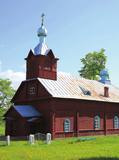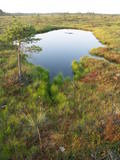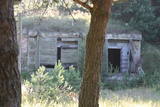| Nr | Name | Beschreibung |
|---|---|---|
|
Das Café befindet sich im historischen Zentrum von Tukums. Hier werden köstliche lettische Leckereien angeboten: Brötchen, Blechkuchen und Piroggen. |
||
|
Der Burgberg befindet sich in Laši, 0,2 km von der Straße Vecumnieki – Ilūkste entfernt. Dieser Hügel ist ein alter Burgberg der Selen, der vom 1. Jahrtausend vor Christus bis zum 10. – 12. Jh. nach Christus bewohnt war. Heute kann man auf dem Burgberg die Ruinen des ehemaligen Landgutkomplexes von Veclaši (Tiesenhausen) sehen, von dem sich nur das Wirtschaftsgebäude, die Fundamente des Schlosses, einige Torfragmente und der Park erhalten haben. Das eindrucksvolle Herrenhaus war am Ende des 19. Jhs. im neogotischen Stil gebaut worden. Bis zum Jahr 1920 befand sich das Landgut im Besitz der Grafen-Familie Przeździecki (zuvor – Tiesenhausen, Vietinghoff). Bevor Sie diesen Ort besuchen, schauen Sie bitte die alten Fotos von dem Herrenhaus im Internet an. Leider hat dieses Kulturdenkmal in den letzten 20 Jahren keine besonderen Renovierungen erlebt. |
||
|
Am Fluss Navesti befindet sich der Bauernhof Energia, die grösste ökologische Kräuter-und Heilpflanzenfarm talu in Estland. Im Kräuterzentrum des Hofes sind Lehpfaden für Heilpflanzen, Modernes Teehaus, das Seminarhaus und Öko-Spa. Kompfortable Beherbergung. |
||
|
Ancient trading routes provided not just goods, but also knowledge and culture. The Light’s rout relates to the Reverent Ernst Gluck, who was a writer, the first translator of the Bible into Latvian, and a founder of Latvian children's schools, the Hernhutian movement of brothers, Kārlis Skalbe, the Kaudzīte brothers, Jānis Poruks, Antons Austriņš and their spiritual heritage. People in Vidzeme bake rye, wheat, barley, spelt and grit bread with various seeds, caraway seeds, nuts, dried fruit and hemp seeds. Hemp is used to produce traditional butter, oil and dumplings made with grey peas. It is also added to candies and even chocolate. Barley flour in the past was used only for celebrations, but today people will teach you how to use it to bake water pretzels with salt and caraway seeds. Visit farms and restored windmills to track the route of grain. Taste traditional Summer Solstice cheese, as well as Green cheese and tasty goat cheese. Pipe perch from Lake Burtnieks is a local delicacy, and you will also find trout, catfish and sturgeon, as well as crabs in season. Local meat and fowl dishes are popular, including dishes made with rabbit. Kitchens at aristocratic estates will offer wild game and pheasants with forest goodies and wild herbs. In Vidzeme you can meet the Garlic Queen, who prepares plant powders. Enjoy pies, sheet cakes, honey cakes, desserts of whipped cottage cheese, mountain ash, quince, apples, sweet cream and rye bread, as well as blackberry or apple dumplings. Slake your taste with herbal teas with honey, birch juice, berry lemonades or, if you're looking for something stronger, some tasty beer or wine. |
||
|
Saimniecības pamatnodarbošanās ir diļļu audzēšana un to pārstrāde. Siltumnīcā audzē arī Itālijas dienvidos zināmu melones un gurķa krustojumu "Carosello", kas latviski nodēvēts par "pūkaino gurķi". Iespējamas degustācijas, kā arī saimniecības produkcijas iegāde. |
||
|
Der Hof der Familie Žiliai ist ein reiner Familienbetrieb, gegründet und betrieben von nur einer Familie, Neugierige Besucher können beim herumspazieren sehen, wie weiße Pfaue, Fasane, Enten, Hühner, Ponys, Rinder der französischen Rasse Charolais und einheimische weiße Schweine. |
||
|
Atrodas Ventspils Rātslaukuma rietumu pusē iepretim Nikolaja luterāņu baznīcai. Ēkas pirmsākumi ir meklējami 18. gs. 1850. g. tajā atradās pilsētas Rātsnams, kopš 2006. g. - rakstnieku un tulkotāju māja, kurā patstāvīgi uzturas un strādā Latvijas un ārvalstu literāti. |
||
|
Die Haupttätigkeit des Hofs liegt im Gartenbau: Tomaten, Äpfel, Birnen, Himbeeren, Erdbeeren usw. Im Frühling kann man den blühenden Obstgarten und die Himbeerplantage besichtigen, im Herbst kann man auch an der Ernte teilnehmen und die speziellen Tragetaschen für die Apfelernte und die Erntezüge ausprobieren. |
||
|
Beliebte und eine der ältesten Straßen in Jurmala zwischen Dzintari und Majori. Die 1,1 km lange Straße mit Wirtshäusern, Sommercafés und Souvenirladen. |
||
|
Ein von der Bildhauerin Solveiga Vasiļeva 2003 errichtetes Gedenkzeichen „Gottesohr” für Staburags befindet sich im Park von Vīgante am Platz, wo nach der Errichtung des Stausees des Wasserkraftwerkes von Pļaviņi eins der interessantesten geologischen Naturdenkmäler Lettlands unter Wasser gesetzt wurde. Staburags war ein von Sagen, Legenden und Erzählungen der Flößer umwobener 18,5 m hoher Kalksteinfelsen am linken Ufer des Daugava-Kanjons, das nach der letzten Eisperiode gebildet wurde. Aus dem Felsen floss die Quelle Liepavots, die auch unter Wasser gesetzt wurde. Der Felsen Staburags und das versunkene Daugava-Kanjon waren einige der populärsten touristischen Objekte Lettlands. |
||
|
Tiskādi Old-Believers Prayer House was built in 1886 and reconstructed
in 1905. The large church was sanctified 100 years ago. It is situated in the district which is mostly populated by Old Believers. The church stands on the hill.
|
||
|
Dieses Territorium wurde zum Schutz der Hainbuche eingerichtet, die ungefähr 4% des Gebietes bedeckt. Der optisch interessanteste Teil des Gebietes ist jedoch der Tīrspurvs – Sumpf, auch als Dunika - Heide bekannt. Hier findet der Besucher Lettlands längsten und beeindruckendsten Sumpfpfad, der das Gebiet von Norden nach Süden durchzieht. Der Besucher wird fasziniert sein von der einzigartigen Landschaft des zentralen Teils des Sumpfes, wo es an einigen Plätzen nicht einmal kleine Sumpfkiefernbäume gibt. Es gibt verschiedene Biotope – kleine Sumpfseen, mineralische Inseln, Wasserlachen usw. Ganz zu schweigen von all den Vögeln in diesem Gebiet.
|
||
|
Karņicka kalns pēc savas izcelsmes nav kalns, bet gan Daugavas ielejas nogāzes daļa ar labu skatu uz Krāslavas mazstāvu koka apbūvi. Ar šo vietu saistīts traģisks nostāsts par poļu virsnieka Josifa Karņicka un grāfa Plātera meitas mīlestību, kurai nebija lemts piepildīties tā laika „paražu” dēļ. Tā rezultātā abi nelaimīgie nolemj izdarīt pašnāvību. Virsnieks nošaujas, bet Emīliju pēdējā brīdī izglābj kalpone, neļaujot tai izlēkt pa pils logu. J. Karņicka pašnāvības vietā ir uzstādīts piemineklis. Nedaudz tālāk – rietumu virzienā guļ t.s. Austriņa akmens, pie kura 1909. gadā iedvesmojies un radījis latviešu rakstnieks Antons Austriņš. |
||
|
Barke von Peipussee ist ein Segelboot, das im Gebiet Peipussee und Fluss Emajõgi zum Gütertransport benutzt wurde. Spezielle für hiesige Verhältnisse passende Boote wurden schon im 14. Jahrhundert gebaut. Im Jahr 2006 hat man nach fünfzig Jahren Pause wieder eine Barke am Fluss Emajõgi gebaut und als „Jõmmu" genannt. Der Barke-Verein (Emajõe Lodjaselts) organisiert verschiedene Vergnügungsreisen auf dem Fluss Emajõgi und auf dem Peipussee. Die Barke "Jõmmu" wartet auf kleinere Barke-Fans, um die traditionelle Handwerk und Schiffbau zu präsentieren. |
||
|
Das Café befindet sich im Zentrum von Aglona an der Straße nach Dagda (P 60). Lettische Küche: Schweinefleischfrikadellen, Kartoffeln mit Hering und Sauerrahm, Quarkcreme mit Erdbeeren. Das besondere Gericht: Rouladen. |
||
|
Natürlich angebaute Heilpflanzen, Abende am Feuer, nach besonders auserwählten Rezepten zubereitetes Essen. Im Bauernhof Energia werden Heilpflanzen angebaut, Waren und Dienstleistungen angeboten, die mit den Heilpflanzen und der positiven Energie verbunden sind. |
||
|
The owners have made sure that everyone can buy fresh and processed fishery products from local producers. During the summer, on the terrace, you can listen to Mazupīte's water, enjoy freshly grilled fish, as well as enjoy particularly delicious cakes, coffee and ice cream. |
||
|
This is a miniature zoo next to a tributary of the Ogre River, and most of it is taken up by a paddock of rabbits. Children just love the animals, as well as the hutches that were designed on the basis of the architecture of estates and castles. There are also goats, pigs, geese, peacocks, mandarin ducks and pearl hens. Children can help in feeding the animals. |
||
|
In der Zeit der Sowjetunion war die Aufgabe der Armeebrigade 77 für Zenitraketen die erfolgreiche Flugabwehr an der äußeren Grenze der UdSSR. Zur Zeit ist das Objekt im Besitz von der Selbstverwaltung des Gebietes. Das Objekt ist verlassen, nicht bewacht und es wird nicht genutzt. Am Haupteingang der Station der Raketen ist ein interessantes Tor erhalten geblieben.
|
||
|
Lietuvas lielākais sūnu purvs, kura aizsardzības nolūkā ir izveidots Čepkeļu dabas rezervāts (Čepeklių gmatinis rezervatas). Tas izvietojies starp Dzūkijas nacionālā parka dienvidaustrumu daļu un Baltkrieviju. No Marcinkones pa smilšainu meža ceļu (~ 9 km turp - atpakaļ) ar kājām vai divriteni (arī nelielu tūrisma autobusu līdz 20 vietām) var nokļūt līdz purva malai, kur mežainās kāpās un purvā izveidota 1,5 km gara dabas taka un skatu tornis, no kura labi pārredzama purva rietumdaļa. Pirms došanās uz Čepkeļu purvu, ir jāreģistrējas Dzūkijas nacionālā parka apmeklētāju centrā (Šilagėlių gatve 11), kas meklējams aiz dzelzceļa pārbrauktuves. Te apskatāma neliela nacionālajam parkam un rezervātam veltīta ekspozīcija. |
||

























